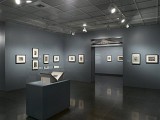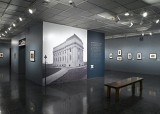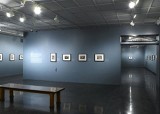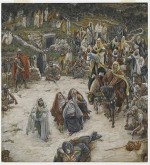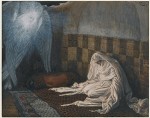The browser will either open the file, download it, or display a dialog.
James Tissot: "The Life of Christ"
Brooklyn Museum of Art, Brooklyn, New York
23 October 2009–17 January 2010
Accompanying Book
James Tissot: The Life of Christ. The Complete Set of 350 Watercolors.
Judith Dolkart, ed.
London: Merrell Publishers, 2009. 302 pages; 403 color illustrations: 350 Tissot watercolors and 53 other illustrations; bibliography; index.
$59.59
ISBN: 978-1-8589-4496-8 (hardcover); 978-0-8727-3164-6 (softcover)
Even for the most enthusiastic and courageous revisionists, nineteenth-century religious art has long been the last frontier. In large part, this was due to its persistent survival, often in degraded form, in contemporary popular religious visual culture, such as mass and prayer cards, illustrations of catechisms, religious calendars, and embroidery patterns. This caused most art historians, even at the height of art historical revisionism in the 1970s and 1980s, to quickly dismiss nineteenth-century religious art or to ignore it altogether.[1]
Since the end of the 1980s, the trend to study art not in isolation, but within the larger context of visual culture has helped to refocus attention on categories of art previously neglected. Nineteenth-century religious art is one of those categories. Ironically, as popular religious visual culture and its history became a subject of study,[2] the interest in nineteenth-century religious art also has revived.[3] Art historians have come to realize that more than an endless and mindless rehash of Italian Renaissance and Baroque models—Raphael's Sistine Madonna or Guido Reni's Head of Christ Crowned with Thorns—nineteenth-century religious art is part of a broad and varied production of visual culture that comprises not only devotional images, but also illustrated bibles, engravings and photographs in travel books about the Holy Land, and illustrations in books and articles on Biblical archaeology. Moreover, religious art in the nineteenth century cannot be separated from the most important theological effort of the nineteenth century, the critical investigation of the life of Jesus.[4]
The recent exhibition of 124 of the 350 watercolors by James Tissot, made to illustrate the artist's well-known La Vie de Notre-Seigneur Jésus-Christ or The Life of Our Saviour Jesus Christ (henceforth The Life of Christ), held between October 23, 2009–January 17, 2010 at the Brooklyn Museum, must be seen as part of the trend to reconsider nineteenth-century religious art through the wide-angle lens of visual culture. It was also an opportunity to show a body of work that is visually stunning and, one realized after viewing the exhibition, irreproducible. Indeed, even the best modern reproductions (like the ones found in the excellent book that accompanies the exhibition) do not do justice to the spellbinding quality of these miniature paintings, the largest dimension of which rarely exceeds 10 inches.[5]
Tissot's watercolors were long considered an embarrassing anomaly in the oeuvre of an artist known for his dazzling scenes of fashionable Parisian and London life. Scholars working on the artist, by and large, ignored them, and the Brooklyn Museum has not exhibited them since the 1980s, despite the fact that not a week goes by without an inquiry about the watercolors, mostly by visitors who know the images through reproductions in Sunday school textbooks and catechisms (8).
Judith Dolkart, the Brooklyn Museum's Associate Curator of European Art and the organizer of the Life of Christ exhibition, sensitively installed it to meet the needs of different publics.[6] For visitors interested in the religious content of the exhibition, she hung the watercolors in the chronological sequence of the life of Christ, as they were arranged inTissot's Life of Christ (fig. 1). For visitors more interested in the history and context of the watercolors, Dolkart interspersed some of the preliminary drawings for the watercolors, made by Tissot during his travels to Egypt and Palestine. She also included a documentary section about the fascinating story of the acquisition of the watercolors by the trustees of the newly opened Brooklyn Museum (1897), who saw Tissot's series as a way to attract visitors (fig. 2). To obtain the funding for the acquisition, they organized a public subscription in Brooklyn, which was supported and promoted by the popular newspaper, The Brooklyn Eagle (35-47). In 1901, a little more than a year after they arrived in Brooklyn, the watercolors, reframed and mounted in gold mattes, were installed in especially designed galleries. Some of the architectural elements of these galleries, specifically two pediments that crowned their entrances, were included in the exhibition (fig. 3).
The origin of Tissot's remarkable series of watercolors, ostensibly, was the artist's transformative religious experience in the Parisian church of Saint-Sulpice in 1885. It caused him to abandon his mundane life as a successful painter of British and French society life to travel to Egypt, Syria, and Palestine in 1886–1887, and again in 1889. Here he visited the sites where Christ walked as a child, preached as a young man, was crucified, and arose from death. The ultimate goal of these travels was to produce a series of watercolors for an illustrated biography of Jesus, in which the images were accompanied by biblical texts from the four gospels as well as Tissot's descriptions of scenes he had observed on his travels. An illustration of Christ's entrance into Jerusalem, for example, is accompanied by part of two verses from the gospel of Matthew: 21, and by a description of the current situation and history of the city of Jerusalem. Though Tissot's renewed embrace of religion was an important motivation for the project, the artist cannot have been oblivious to the enormous success of similar projects, most notably the famous Doré Bible (1865–1866), featuring illustrations by the French illustrator Gustave Doré.[7] This illustrated bible had been produced not only in folio and various smaller-size formats, but also in many languages. Moreover, the illustrations, without text, were published in so-called Doré Gallery editions, which were enormously popular.
Tissot's project was deliberately different from Doré's. Not only did he narrowly focus on the life of Christ (though later he would also produce a series of illustrations for the Old Testament),[8] but he also countered the Romantic fantasy of Doré's imagery with a new verism, based on his trips to the Holy Land, where he made countless preliminary drawings and probably photographs (though none of these are known today). In her introductory essay, Dolkart shows that most urban and landscape settings of Tissot's scenes of the Life of Christ are based on scenes he had drawn in Palestine (17-19). The same is true for many of the figures, which are directly based on studies of different "types" made during his trips (19-21). As Dolkart writes, Tissot imagined that the Holy land was "unchanged since the birth of Christ," though he had no illusion it would stay that way (13). The success of Tissot's watercolors appears to be related to his careful negotiation of a number of contradictory impulses. These include (1) verism, i.e., truthfulness to the physical appearance of Palestine and its people; (2) an attempt to newly imagine the gospel scenes, particularly those involving miracles; and (3) respect for tradition, coming from the realization that the images had to be recognizable if the project was to be successful, i.e., offer a connection to the familiar representations of the life of Christ. The result was a series of watercolors that are highly original in conception, but not so eccentric that one does not recognize the biblical scene. To mention just one example, What Our Lord Saw from the Cross shows a unique view of Golgotha as if seen by Christ looking down from the cross (fig. 4). But though the viewpoint is unique, the traditional iconographic ingredients—fainting Virgin, apostles, and centurions---are all there.
In addition to the originality of their conception, Tissot's technical skill enabled him to suggest vastness and multitude within watercolors that generally measure less than 8 x 10 inches (fig. 5). Moreover, his use of color is remarkable, not only in the watercolors with richly costumed figures, but also in visionary scenes, such as the Annunciation (fig. 6). Combined with his unbelievable attention to detail, all contribute to make this a remarkable series.
The Tissot exhibition was accompanied by an excellent book, edited by Dolkart with essays by the author and by David Morgan, author of Visual Piety: A History and Theory of Popular Religious Images (1999).Dolkart's first essay describes the genesis of The Life of Christ and presents a perceptive analysis of the watercolors; her second essay provides a fascinating account of the acquisition of the series by the Brooklyn Museum, citing many of the contemporary opinions, both positive and negative, of the merits of the watercolors. Morgan's essay places Tissot's imagery in the context of nineteenth-century American visual culture. All 350 watercolors for the Life of Christ are reproduced in the book, which is an important addition not only to the Tissot literature, but also to the literature on nineteenth-century religious art.
Petra Chu
Seton Hall University
Petra.chu[at]shu.edu
[1] A notable exception is Michael Paul Driskel, Representing Belief: Religion, Art, and Society in Nineteenth Century France (College Park, PA: Pennsylvania State University Press, 1992).
[2] David Morgan, Visual Piety: A History and Theory of Popular Religious Images (University of California Press, 1999); David Morgan and Sally Promey, eds., The Visual Culture of American Religions (Berkeley: University of California Press, 2001).
[3] See Kristin Schwain, Signs of Grace: Religion and American Art in the Gilded Age (Cornell University Press, 2007); and Michaela Giebelhausen, Painting the Bible: Representation And Belief in Mid-Victorian Britain (London: Ashgate, 2006).
[4] The classical overview of this quest, pursued by such writers as David Friedrich Strauss and Ernest Renan, was written by Albert Schweitzer in 1906. His text was translated in 1910 as The Quest of the Historical Jesus: A Critical Study of its Progress from Reimarus to Wrede. The book may be found on line at http://www.earlychristianwritings.com/schweitzer.
[5] To see on-line reproductions of all 124 works that were included in the exhibition, in addition to a series of installation views, see http://www.brooklynmuseum.org/opencollection/exhibitions/3207/James_Tissot%3A_The_Life_of_Christ.
[6] As of January 2010, Dr. Dolkart has assumed the position of Chief Curator of the Barnes Foundation in Philadelphia.
[7] On the Doré Bible, see Eric Zafran, ed., Fantasy and Faith: The Art of Gustave Doré, (New Haven: Yale University Press, 2007), 65-68.
[8] These watercolors, which remained unfinished at the time of the artist's death, were subsequently completed by other artists. Today they are in the Jewish Museum in New York.


